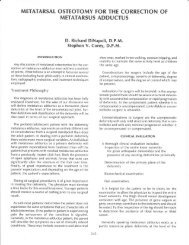lateral pain syndromes of the foot and ankle - The Podiatry Institute
lateral pain syndromes of the foot and ankle - The Podiatry Institute
lateral pain syndromes of the foot and ankle - The Podiatry Institute
Create successful ePaper yourself
Turn your PDF publications into a flip-book with our unique Google optimized e-Paper software.
Figure 7. Radiographs <strong>of</strong> a patient who underwent<br />
cavus <strong>foot</strong> reconstructive surgery. Note that <strong>the</strong>re<br />
is cortical hypertrophy <strong>of</strong> <strong>the</strong> fourth <strong>and</strong> fifth<br />
metatarsals. This is consistent with <strong>lateral</strong> overloading<br />
<strong>of</strong> <strong>the</strong> <strong>foot</strong> that can cause dorso<strong>lateral</strong> <strong>foot</strong><br />
<strong>pain</strong>.<br />
Figure 9. Radiograph <strong>of</strong> a Jones fracture. Note <strong>the</strong><br />
underlying metatarsus adductus.<br />
When a patient presents to <strong>the</strong> <strong>of</strong>fice with <strong>lateral</strong> <strong>ankle</strong><br />
<strong>and</strong>/or hind <strong>foot</strong> complaints, diagnosis is more difficult<br />
than medial complaints due to <strong>the</strong> proximity <strong>of</strong> anatomic<br />
structures <strong>of</strong> joints, ligaments, <strong>and</strong> tendons. Careful interpretation<br />
<strong>of</strong> symptoms including <strong>pain</strong> <strong>and</strong> instability in<br />
conjunction with a thorough clinical examination is<br />
paramount. <strong>The</strong> examination should include careful<br />
palpatory <strong>and</strong> range <strong>of</strong> motion maneuvers, laxity testing<br />
<strong>of</strong> <strong>the</strong> <strong>ankle</strong>, manual muscle testing <strong>of</strong> <strong>the</strong> peroneals,<br />
CHAPTER 3 17<br />
Figure 8. Radiograph <strong>of</strong> an avulsion fracture <strong>of</strong> <strong>the</strong><br />
fifth metatarsal. Note <strong>the</strong> underlying metatarsus<br />
adductus.<br />
Figure 10. MRI illustrating a stress fracture <strong>of</strong> <strong>the</strong> cuboid. This is a less<br />
common source <strong>lateral</strong> <strong>foot</strong> <strong>pain</strong>.<br />
diagnostic anes<strong>the</strong>tic injections, radiographs <strong>and</strong> MRI if<br />
necessary. MRI is generally used as a confirmatory study as<br />
we typically know what is wrong <strong>and</strong> want to rule out<br />
o<strong>the</strong>r less common pathologies (Figure 10).<br />
For <strong>the</strong>se clinically challenging cases, I find it<br />
particularly helpful to examine patients multiple times.<br />
Subsequent examinations on a patient with a complicated<br />
case make <strong>the</strong> clinical diagnosis clearer. I always reevaluate<br />
a patient after an MRI so that I can focus on MRI

















